Confounding complexity, turf tension, head scratching and horse-trading. Inspiration, compromise, exhilaration and, ultimately, enchantment.
The team that shaped a mall to end all malls—Singapore’s all-but-complete Jewel Changi Airport—quashed myriad conflicts during the job. The architecture of the 135,700-sq-meter land-side mall, camouflaged by a vast atrium garden with a record-tall waterfall, divided, united and energized its creators.
“It’s devilishly complex and it’s amazing,” says Meredith Davey, a director of the garden’s London-based indoor-environment consultant, Atelier Ten.
The project, masterminded by design architect Moshe Safdie, would have been difficult enough, considering the busy airport, limited site access and a congested location, with an active elevated train slicing through the center. But the usual constraints of airport expansions don’t hold a candle to Jewel, which is no ordinary mall—airport or not. Its retail levels are hidden by a five-level forest under glass, complete with canyons, a valley and a 40-m-tall waterfall.
“The whole building is a new-scale experience,” says Safdie, founder of the 85-person Safdie Architects, Boston. “When that water comes down, it’s powerful,” says the architect, best known recently for Singapore’s Marina Bay Sands complex, with its surfboard-shaped rooftop park that spans and joins three towers.
Obsession with Gardens
For the more than $1.25-billion Jewel, Safdie, who turns 81 on July 14, combined his lifelong obsession with gardens, water features and human habitat. The 5.6-acre Gardens at Jewel, sited before airport security yet linked to three of the four terminals, not only draws travelers, but is a magnet for the community.
“It’s a new typology,” says Jaron Lubin, Safdie’s principal-in-charge.

Courtesy of Safdie Architects
The job was challenging because Safdie called for a visual separation between the mall and the greenery. “Commerce and the garden shouldn’t touch,” he says. “It’s an interesting precedent, not specific to airports, and one of the most complex things I’ve done.”
Maintaining the forest’s pristine appearance demanded intense collaboration. “We worked really hard to make it look easy,” says Tony Freitas, project director for the Burbank, Calif.-based water feature consultant, WET Design, known for the Bellagio Fountain in Las Vegas.
The waterfall, the scale, the tropical climate, the commingled human and plant habitats and the steel- and-glass enclosure’s asymmetry conspired to challenge the entire team. “In some ways, Jewel is uncharted territory,” says Adam Greenspan, a partner of PWP Landscape Architecture, known for Lower Manhattan’s 9/11 Memorial garden and Marina Bay Sands.
The biggest wrench in the works was the waterfall, dubbed the HSBC Rain Vortex. Some 33 m in circumference, the 11-m-dia waterfall is a scaled-up version of Safdie’s air-side installation at Ben Gurion International Airport in Tel Aviv. That feature is 8.5 m tall.
Jewel’s waterfall is also entertainment. It serves as a 360˚ screen for sound and light shows, run at night. Safdie and PWP did not want any of the 56 speakers or 12 projectors to be visible in the garden.
Horse-Trading
“There was a lot of horse-trading” to work out equipment locations, says WET’s Freitas. “Eventually, we came to a mutually unsatisfactory agreement,” he adds. The goal was for “everyone to be equally unhappy,” he says, only half joking.
The group functioned like a bridging design-build team, taking documents through design development and then handing them to the design-build contractor, the Woh Hup-Obayashi Joint Venture. RSP Architects Planners & Engineers Pte Ltd. is both executive architect and structural engineer. Mott MacDonald is the mechanical-electrical-plumbing engineer.
Though not the architect of record, Safdie insisted, as always, on staying involved through construction. “We worked very closely with the contractor,” says Charu Kokate, the Safdie principal who led four other architects on site. “It was hard to tell who was the architect and who was the contractor,” she says.
The five-story building resembles a doughnut-shaped spaceship. The roof’s steel-and-glass thin-shell diagrid structure, called a gridshell, has an asymmetrical toroid shape, which complicated the geometry. The warp was caused by the need to position the oculus opening for the cascading rainwater slightly off center, to avoid a rain storm hitting the elevated train.
Landscaped Terraces
Inside, the reinforced concrete building resembles an amphitheater. But instead of seating tiers, four levels of landscaped terraces overlook the garden expanse. The terraces hide mall space from garden space.
The uppermost two of five basements are part of the mall. The three lowest are for parking and back of the house functions. Jewel also has a hotel, a movie theater and airport services such as early check-in counters and passenger lounges.
In 2013, Safdie was invited by developer CapitaLand to enter a competition for Jewel. The mindset of CapitaLand and its 51% partner, the government-owned Changi Airport Group, was for a high-end mall around an amusement or theme park.
Instead, Safdie proposed a “timeless” garden. The client was hesitant at first. “The idea clicked when we made the first model and sketches,” says Safdie.
Though the official opening will be in the fall, the building had its soft opening in April. “On Easter Sunday, there were 600,000 visitors,” says Safdie. “That’s one-tenth of Singapore’s population,” he says.
Largest Gridshell
Jewel is covered by the world’s largest gridshell to enclose a building, according to the roof designer, the New York City office of Buro Happold (BH). Jewel’s asymmetrical gridshell is roughly 210 m by 156 m in plan. A gridshell-covered walkway linking pavilions at the Milan Trade Fair is 1,300 m long and 30 m wide.
Gridshells are a structurally efficient way to span large distances. Known as thin shells, they are shallower, for the same span, than trusses or space frames.
The gridshell stops at the perimeter of level 5 (L5), but the facade, which looks the same, continues to the ground. The cover weighs 6,000 tons.
The roof structure contains more than 6,000 solid steel nodes and 15,000 members. Because of the off-center oculus, each node and every member is slightly different but visually similar.
Nodes generally receive six members, which enter the node at different angles and have different depths.
“Each piece only fit in at one place, like a 3D puzzle,” says Cristobal Correa, BH’s associate principal. “Slightly different doesn’t cost any more,” he adds, thanks to computer-controlled fabrication.
There are more than 9,304 triangular glass roof panels, each also slightly dimensionally different. One glass panel weighs about 250 kilograms. The panels, which are coated to transmit light for plant growth, do not function as a diaphragm for the gridshell.
“In some ways, Jewel is uncharted territory.”
– Adam Greenspan
Partner
PWP Landscape Architecture
Even with increased curvature for added stiffness, shells are very susceptible to large-scale deflections, especially when first loaded, says BH. A safety factor of three or four further stiffens the members.
“We had to give the contractors a lot of confidence they could bid this,” Correa says.
BH provided computer design files to the fabricator. The 50 sheets of 2D drawings served as a guide for the data use. “Drawings don’t cut it when describing a complex surface,” Correa says.
Roof contractor Mero Structures Inc., which fabricated the nodes and farmed out the members, was not available for comment. Neither were any of Jewel’s other suppliers or subcontractors, except WET.
The gridshell is supported along the building’s perimeter and along an inner ring of 14 tubular-steel “tree” columns that bear on the concrete structure. Each tree has four slanted trunks that range from 10.3 m to 10.9 m in height.
The curved yet faceted form, which has no bilateral symmetry, is broken into triangles made up of visually consistent 120-mm-wide rectangular hollow sections (RHSs) of variable depths. Triangle sizes vary and are limited to 2.5 m x 2.5 m, to keep from exceeding the largest standard glass panel sizes.
The RHSs are mostly bolted to the machined nodes, but some are welded, depending on the loading.
The gridshell’s outer elliptical ring spans from the building’s perimeter to the tree columns. In this area, arch action keeps most of the depth to 350 mm.
The cone-shaped dipped section of the off-center oculus cantilevers from the tree columns and creates a compression field in the gridshell immediately above the columns.
Most Complex
It’s the most complex zone, says Correa. Significant moments generated are resisted by deeper beam-type elements, up to 750 mm deep.
The roof’s central area between the compression ring and the oculus is a tension field. There, where loads are lighter, the elements are the smallest, with depths of 250 mm.
Wind tunnel testing by CPP Wind Engineering helped BH with the analysis and design. Computing power has evolved to allow this. “We would have had to guess 30 or 40 years ago,” says Correa.
The garden’s vast expanse that begins at grade on L1 is called the Shiseido Forest Valley. It has a 21,000-sq-m footprint. Visitors can walk up two trails to L5, via the terraces. Along the way they can stop, shop and eat.
The L5 Canopy Park, which opened earlier this month, is a 14,000-sq-m space just under the roof. It contains play areas, themed gardens and eateries.
More Vulnerable
The design team went to great lengths to create the natural look of the Canopy Park and the Forest Valley. A chilled greenhouse on structure in a tropical climate, with a vast skylight, is more vulnerable than a heated conservatory or a hothouse. Tree selection, growth, placement, planter shape and depth, and tree watering and maintenance are all different.
In its design, PWP even had to account for the shadows cast by the gridshell. “There’s no catalog of plants for this,” says Greenspan.
Jewel houses more than 2,000 trees and palms, as tall as 13 m, and over 100,000 shrubs. The low-humidity plantings are imported because native tropical plants would not flourish in a chilled space. The 120 species hail from Australia, China, Malaysia, Spain, Thailand and the U.S.
The lead time for tree procurement was two years. Trees were pre-grown for 18 months to two years at a nearby nursery, covered to mimic light levels in Jewel. Trees that did not thrive were switched out. Plants and shrubs were tested for six months.
Transplanting at the site began in March 2018. Greenspan says that, to date, only one tree has died, but that was before the soft opening. “So far, so good,” he says.
For WET, which designed, engineered, fabricated, choreographed shows and commissioned the rain vortex, the project also breaks new ground. It represents a novel approach to controlling, manipulating and sculpting water, says Freitas.
“There were no precedents, so the whole process was one of discovery and learning,” he adds. “We had to deal with the realities of physics, economy and budgets while staying true to the architect’s vision.”
Mock-Ups
For help, WET turned to computer modeling, even for noise, and to mock-ups of different sizes, applying lessons learned from one to the next. One mock-up was full scale.
WET even built a mock-up of a section of the roof. “One concern was the weight of water, particularly near the oculus,” says Freitas.
The waterfall is 10 m taller than the previous record holder at Singapore’s Gardens by the Bay. But breaking the height record was not intentional, says Freitas.
The feature is fed by rain collected over 7,500 sq m of roof area, with flows of up to 10,000 gallons/minute during the heaviest storms. Water cascades down the 11-m-dia oculus, falling into the garden in a continuous parabolic arch, rather than in a straight line.
The water lands in a pool in the mall’s B2 shopping level, two floors below the garden floor. Between B1 and B2, there is a 14.5-m-tall circular acrylic wall, separating the water and spray from visitors.
Water then goes to holding tanks on B3. Captured water is used to run the feature by filtering and treating it, then recirculating it to the roof, which has piping aligned with the structural members. In total, the recirculation system contains more than 3.6 km of piping, which had to be hidden from view.
Water is pumped horizontally to the building perimeter and then vertically to L5, where another set of pumps moves it to the roof.
When B3 holding tanks are full, water is diverted for other uses. If the level is low, the tanks are topped off using new water.
Wind Patterns
WET worked closely with Safdie and PWP to place projectors and speakers. It also worked with Atelier Ten to study potential interior wind patterns generated by the falling water and the impact on visitors. “We did a mock-up with people, which we had not done before,” says Atelier Ten’s Davey.
Atelier Ten “sat in the middle of all the consultants, including the cladding consultant, to help balance different tensions for the best solution,” Davey says.
Occupied spaces are 24˚ C, with 60% relative humidity. Achieving that required the correct amount of daylight—which meant optimizing the skylight—for plant life. But too much solar penetration would interfere with human comfort.
Just like WET, Atelier Ten had to hide ductwork that would disturb the faux-natural environment. That was not easy. Absent drop ceilings on the Forest Valley floor, terraces or Canopy Park, which were the main garden areas conditioned, Atelier Ten had to work with the architect to hide ductwork in terrace floors, along the garden’s edges and under walkways and benches.
Atelier Ten’s experience with Gardens by the Bay, which when it opened in 2011 was the world’s largest cooled greenhouse, helped. The project taught them that underfloor cooling, where there are hard finishes, is the best way to absorb solar gain.
Atelier Ten also learned that waterfalls generate greater air movement than expected. “How much air gets dragged by a single drop of water is easy to calculate,” says Davey. Ten million droplets complicates the question.
The firm uses computer-based analysis and computational fluid dynamics to model air flow. For Gardens by the Bay, the firm wrote software for the daylighting analysis. In 2006, “it took two to three weeks to get an analysis done. By the time we started Jewel, the same analysis took six hours, thanks to an optimized approach and increases in computer power,” says Davey.
Jump Start
The garden was tough to design. Construction was no walk in the park, either. Woh Hup, which led the joint venture, had to abide by the many airport rules and regulations that kept construction from compromising airport operations. To get a jump start, the design-build contractor was brought on board well before construction began in October 2014.
Logistics were tricky, says Safdie’s Kokate. Crews, materials and equipment had to enter from the south—a tangle of airport access roadways.
The site, a former surface parking lot, lay between the control tower and Terminal 1, to the north. All the utilities and services that ran through the site from the tower to the terminal had to be relocated. The active train, which connects terminals 2 and 3, was cocooned in a shed to protect it throughout construction.
To speed things, Woh Hup used top-down construction. Crews began with the installation of diaphragm walls and bored piles. The operation was split into two phases to maintain a roadway for taxis delivering passengers to terminals.

Excavation work began after the progressive completion of the capping beams on the walls.
Then, from the top down and with the help of six tower cranes and several mobile cranes, crews built the 10 levels of the reinforced concrete building, alternating one basement level down, then one level up.
Beginning in November of 2016, workers began installing a temporary crash deck, starting from B2 below the oculus, that would eventually fill the void between the Forest Valley and L5 level. The deck was planned to coincide with the completion of the L5 slab on the north side of the building, so that scaffolding to aid in roof erection could be installed on top of the crash deck and the completed L5 north slab.
Crews erected scaffolds up to 1 m below the bottom of the roof line to allow for additional customized falsework to be installed to facilitate the erection of gridshell nodes and members.
The protective crash deck enabled the roof and facade work to be conducted concurrently with construction below the deck, says Woh Hup.
The contractor split erection of the roof into 10 wedges, starting in the site’s northwest quadrant. Workers then moved clockwise, erecting wedge after wedge.
Tree columns were installed progressively on L5, as well as supports on the perimeter of the L5 concrete structure. Crews then erected the cantilevered gridshell members from the columns toward the oculus and from the tree columns to perimeter supports.
Nodes and members were hoisted and stick-built, piece by piece, each going into a predetermined place. Three teams of surveyors carried out independent checks of the surveys during the gridshell work.
Crews installed the first glass panel after half of the roof steel was erected, starting from the second wedge. The first wedge was the closure wedge. Glass panels there were installed last.
Workers completed installing glass panels on the second and third wedges before falsework for the second wedge was de-propped. Even at this point of de-propping, the cantilevered sections remained supported to prevent lateral displacement of the structure, says the contractor.
De-Propping
The de-propping process was then repeated for each wedge. The last batch of glass panels were installed on the first wedge only after crews finished installing panels on the tenth wedge.
The de-propping process was progressively carried out wedge by wedge with the supports on the cantilevered part of the roof removed only after crews removed all other props.
After the roof was self-supporting, workers installed the weir of the water feature around the oculus. Crews followed with landscaping on L5 and the Forest Valley, as scaffolding was progressively dismantled.
Safdie says the project exceeds his expectations. “Sometimes, you feel like you are on a hill and can see across the void to another hill,” he says. Then, there are “moments the space feels intimate.”
One surprise is that in the mornings, a rainbow shoots through the waterfall. “We hoped there would be rainbows, but we did not model them,” says WET’s Freitas. “Maybe for the next one.”
WET, which has staff running the waterfall, wants to offer behind-the-scenes tours of the feature’s workings, as a permanent part of Jewel. Freitas says, “There really isn’t anything else quite like it.”

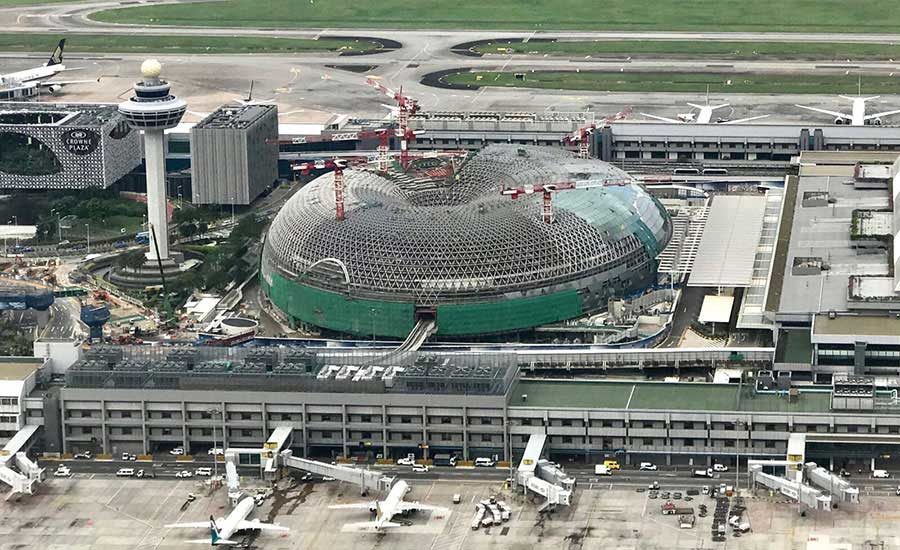
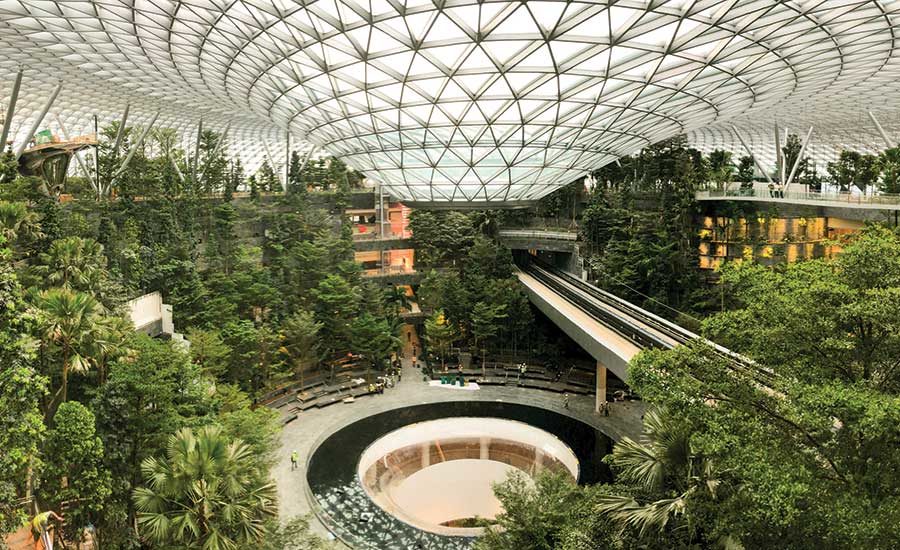








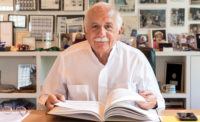
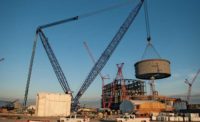
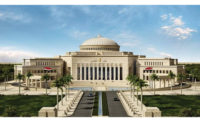
Post a comment to this article
Report Abusive Comment